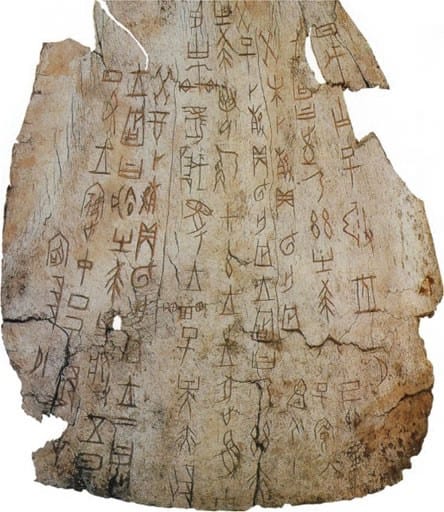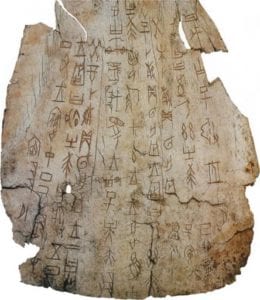Introduction
Continuing from Parts 1 and 2; recorded Chinese history can be traced back to God’s dispersion (confusion) of the languages at Babel and the Chinese knowledge of the events of Genesis before then, which is evident in their ancient culture. Below is part 3 of this three-part series.
Chinese characters
According to tradition, during the reign of the Yellow Emperor Huang Di, the first characters, simple drawings of familiar objects, picture words (pictographs) were invented.[1] Other examples are Sumerian cuneiform and Egyptian hieroglyphics. A much later development is an alphabet which allowed for pronunciation of the written information. Some ancient forms of writing have evolved, to enable the reader to pronounce what was written. Chinese is such a case whereby phonetic complements were inserted in some characters. Chinese like all languages has changed over its 4,000 years of existence. During with the passage of time over the many centuries, the origin and accurate meaning of these original pictographs were lost or became blurred; and even the true meaning of Shang Di also became misunderstood. Superimposed on all of this is stylistic variations of writing characters. However, a major find has provided an insight into early Chinese writing.
Oracle Bone Writings
 The oracle bones were discovered during the 1800s by two Chinese scholars, who noticed inscriptions on turtle shells sold in Chinese medicine shops in Peking. The oracle bones were first excavated and cataloged in 1899 from a site in Anyang, near Yinxu, the ancient capital of the latter part of the Shang Dynasty of China, located in present-day Henan Province. In these and subsequent excavations near Anyang, more than 100,000 oracle bones have been found, inscribed with more than 1.6 million characters.[2] The oracle bone texts are the oldest extant documents written in the Chinese language. They are inscribed on ox shoulder-blades and the flat under-part of turtle shells (as shown). They record questions to which answers were sought by divination at the court of the royal house of Shang 商, which ruled central China between the 16th and 11th centuries BC.[3] These writings go back about 3,500 years.
The oracle bones were discovered during the 1800s by two Chinese scholars, who noticed inscriptions on turtle shells sold in Chinese medicine shops in Peking. The oracle bones were first excavated and cataloged in 1899 from a site in Anyang, near Yinxu, the ancient capital of the latter part of the Shang Dynasty of China, located in present-day Henan Province. In these and subsequent excavations near Anyang, more than 100,000 oracle bones have been found, inscribed with more than 1.6 million characters.[2] The oracle bone texts are the oldest extant documents written in the Chinese language. They are inscribed on ox shoulder-blades and the flat under-part of turtle shells (as shown). They record questions to which answers were sought by divination at the court of the royal house of Shang 商, which ruled central China between the 16th and 11th centuries BC.[3] These writings go back about 3,500 years.
Genesis in the Oracle pictographs
Dr Ethel Nelson provides six examples in her book God’s Promise to the Chinese.[4] I acknowledge and am grateful to Karen Chin for providing me with all of the Chinese radicals and characters that follow.
Radicals which make up Character Modern
the character Character
woman trees desire, covet
There were two trees in the Garden of Eden; the Tree of Life and the Tree of Knowledge of Good and Evil. Genesis 3:6, a woman facing one tree, coveting the fruit, with her back to the other tree conveys the idea of coveting or desiring.
serpent trees negative, no, not
Genesis 3:1-5. The serpent (Satan) lied about the trees and the negative consequences.
mouth (eating) tree restrain
Genesis 2:16-17. God’s command was “ Don’t eat; restrain yourself!”
Tree enclosure difficulty
garden trouble
Genesis 3:16-24. Eating of the tree in the garden brought trouble, difficulty.
Noble person lamb, sheep beautiful
When the Lamb covered their sins, they were beautiful in God’s sight. This was fulfilled in Jesus. John 1:29; 1 Peter 1:17-21; c/f Romans 4:1-8.
Hand lance me sheep righteousness simplified script
Genesis 3:21. The sheep like a garment covers me. But “me” is composed of a hand and a lance, a weapon, which suggests I am ultimately responsible for the death of the Lamb. The death of the Lamb makes me righteous.
There are many more examples included in the Oracle Bone Writings which support the account in Genesis. These can be found in Dr Nelson’s book already mentioned and Ginger Tong Chock’s book; Genesis in Ancient China, Eastwood Garden Publishing, 2015.
Genesis in modern tradition Chinese
Even Traditional Chinese written today, show elements of Genesis are still present in their characters. Ten examples which are taken from a booklet produced by Great Commission Ministry; www.gcm.org.au, follow:
礻+ 一 + 口 + 田 = 福
God one (first) mouth (person) field (garden) blessing
Blessing is what the first man (Adam) had with God in the Garden of Eden, Genesis 2:8.
土 + 口 + 丿 + 辶 = 造
Dust mouth (person) life or motion person walking create
God took the dust, breathed into it and created life in a man who walked, Genesis 2:7.
土 + 儿 + 丿 = 先
Dust son or man life or motion first
God used the dust to create the first man and he became a living person, Genesis 2:7.
田 + 儿 + 丿 + 厶 = 鬼
garden man life or motion secret or private devil, spirit
The devil secretly went into the garden and spoke like a man to Eve, Genesis 3:1-6.
木 + 木 + 广 + 鬼 = 魔
tree tree under cover of devil, spirit evil spirit, demon
There were two trees in the Garden of Eden; the Tree of Life and the Tree of Knowledge of Good and Evil. The devil (evil spirit) came secretly into the Tree of Knowledge of Good and Evil, Genesis 3:1-6.
木 + 木 + 女 = 婪
tree tree woman greedy
The woman rejected the Tree of Life to eat from the Tree of Knowledge of Good and Evil; she was greedy, Genesis 3:6.
木 + 木 + 示 = 禁
tree tree command or sign post forbidden
Adam and Eve were forbidden by God to eat from the Tree of Knowledge of Good and Evil, Genesis 3:15-17.
舟 + 八 + 口 = 船
Vessel eight mouth (people) boat
Obviously, the Chinese knew about the Flood and Noah’s Ark which contained eight people (Noah, his wife and their three sons and three daughters-in-law), Genesis 7:7.
人+ 一 + 口 + 艹 + 土 = 塔
man one mouth (language) grass dust or soil tower
The world had only one language and the people combined to build a very high tower out of mud/clay bricks, Genesis 11:1-9.
羊 + 我 = 義
lamb me righteousness
The next day John saw Jesus coming toward him and said, “Look the Lamb of God who takes away the sin of the world.” John 1:29.
Conclusion
These three blogs concerning the ancient Chinese culture confirm the events recorded in Genesis as real history.
The Bronze Tree of Sanxingdui, is a remarkable representation of the Tree of Knowledge of Good and Evil which Satan used to bring down Adam and Eve. The four thousand years of the Chinese worship of their supreme God, Shang Di and their ritual sacrifice to Him is in accordance with Abel’s and presumably his parents’ sacrifice to God. And finally, the Chinese radicals and characters shown here provide so much confirmation of the Genesis events. All of which combine to support the Hebrew record of biblical history.
Post script
For people who would like to know more on this topic, there are two hour plus youtube videos shown below:
https://www.youtube.com/watch?v=wLyVAE_JYFQ#t=142.689289; https://www.youtube.com/watch?v=NotLi2wZ4Sc.
[1] Ethel R Nelson and Richard E Broadberry, God’s Promise to the Chinese, Read Books, 2014, page 10, citing: Hsin Cheng Yu, Ancient Chinese History, Taipei, Taiwan Commercial Press, 1963, page 6.
[2] http://www.newworldencyclopedia.org/entry/Oracle_Bone_Script.
[3] http://www.lib.cam.ac.uk/mulu/oracle.html.
[4] Ethel R Nelson and Richard E Broadberry, God’s Promise to the Chinese, Read Books, 2014.






